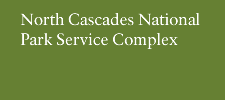 |
 | |
  | |
|
|
|
|
North Cascades National Park Service Complex
Salmon of the Skagit River Watershed
|
|
|
|
|
|
 |
"...among our northern coasts, salmon was once the staple of life. Indians lived on the returning waves of salmon. Several times a year, the silvery benediction thronged up the rivers. The Indians held holy ceremonies, sang to the first spring fish, and carefully returned their bones to the water, that the fish might reflesh and return to feed humankind. The shamans would see them coming in visions, and said they were the people who lived in magic villages under the sea, and who disguised themselves as fish to visit the people of the river. Salmon were not just food, but a connection with the past, the gods, and the great round of life.
To see a salmon run is to see into the veins of the planet. Take an eagle's view of the northwest coast and look down from the imagined air of the past, into rivers flowing red with spawning sockeye, or silvery with homing steelhead. Salmon moved like plasma in the stream, carrying back from the sea the healing substances the river itself once gave up to salt. They brought back the cast-off skin of mayfly, the soft black corpse of mosquito, the faded flash of smaller fish that did not make it to sea. They brought back the bark of alder and the leaf of willow. And when they had battered their way back to the ancestral gravels and spawned, their bodies changed. They aged and diseased and died, returning all these things to the mountain stream, and closing the circle of life.
Millions of salmon struggled thus upriver, sometimes more than a thousand miles from the sea, to die and leave new life in the creeks. It's an event we have regarded as brute profligacy, something lavishly savage. But salmon do not die as we do. They die to give the rivers life. Their flesh goes back to the gravels to feed the young hatchlings. Their bodies wash up on the shorelines to feed scavenging bears and eagles. They take fin and wing again and again. They die, not as error, or sacrifice but as dance and poem, as a song to the roundness of life.
So it was when the land was whole. But we have straightened the circle, dammed the rivers, muddied the waters. The salmon runs are in trouble. And if we take the plasma out of the land's arteries what will happen to those of us who bump about on its skin? The lives of fish and human may be wound around each other in ways we can no longer recall. We are just beginning to find that there is more to rivers than just water. As the fish go, so, ultimately, may we."
--- Peter Steinhart
|
|
The learning objectives for this project:
|
- Students, teachers, and parent chaperones will be able to name the salmon that use the waters in the Skagit River Watershed and North Cascades National Park Service Complex, several of the measures the park is taking for their preservation, and the importance of protecting the salmon.
- Students, teachers, and parent chaperones will be able to describe the importance of the North Cascades National Park Service Complex in the life cycle of at least two of the five species of salmon in the Skagit River Watershed.
- Participants will be able to briefly describe the National Park idea and how it pertains to the preservation of salmon habitat.
|
|
Note: Bold, underlined words are defined in the glossary. Simply click on the word to view the glossary entry for the word. Click on your browser's 'back' button to return to the original page.
|
|
Funding for this project was provided by a Parks as Classrooms grant from the National Park Service.
Edited by: Cindy Bjorklund and Tim Manns
Text by: Paula Ogden
Design by: Arlene Frazier
These materials may be photocopied for classroom use only.
To request permission to use text or graphics for any other purposes please contact our Education Coordinator.
|
|

|
 |
|
|
|
|
|
 |
|
Did You Know?
North Cascades National Park Service Complex includes 684,000 acres near the crest of the Cascade Mountains from the Canadian border south to Lake Chelan.
|
|
|
|
Last Updated: April 19, 2007 at 20:09 EST |





